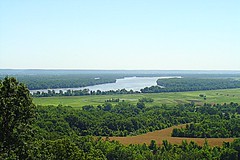| Female Wild Turkeys (Meleagris gallopavo) taken near Rideau River, Ottawa, Ontario, Canada (Photo credit: Wikipedia) |
Improved reproduction last year, plentiful acorns and a mild winter all favor a rebound of turkey numbers.
JEFFERSON CITY–Mild winter and early spring weather shifts the balance a little more in favor of a population rebound for Missouri’s wild-turkey flock, but it won’t have much effect on this year’s spring turkey season, according to the Missouri Department of Conservation (MDC).
According to the University of Missouri’s Historical Agricultural Weather Database, temperatures between Jan. 1 and March 15 averaged nearly seven degrees warmer than the previous 10 years in central Missouri. The temperature at the University’s Sanborn Field in Boone County remained above freezing on 32 days during the same period, compared to just four above-freezing days in 2011.
“With the good acorn crop we had last fall and the very mild winter, our turkey population is in as good of condition as you could ever hope for at this time of year,” says Resource Scientist Jason Isabelle, who is in charge of wild-turkey management for MDC. “Hens should be in great condition going into the nesting season this year.”
That is good news, but hunters are more likely to be interested in how this year’s unusual weather will affect hunting. The answer, according to Isabelle, is not much.
“The warm weather we've been having really does not affect wild turkeys’ breeding and nesting behavior all that much,” says Isabelle. “The amount of daylight is the primary trigger for the start of turkey breeding activities, so even though spring is certainly ahead of schedule this year, it won't make that much difference.”
What will change, says Isabelle, is the amount of foliage on trees during turkey season. Leaves tend to absorb sound, making it harder for hunters to hear turkeys gobble. That can make hunting a bit more challenging, but Isabelle says more-developed foliage also offers hunters an advantage.
“Foliage can work to the hunter's advantage by allowing the hunter to get set up on a gobbler without being seen. A lot of hunters prefer hunting with more foliage on the trees for that very reason.”
Isabelle said going into the 2012 nesting and brood-rearing season in good condition could help Missouri’s turkey flock build on population gains made last year. Field observations of poults (recently hatched turkeys) last summer showed the best nesting success in nearly a decade.
“We aren’t alone,” said Isabelle. “Above-average rainfall has taken a toll on turkeys across parts of the Midwest over the past few years. Poults are susceptible to hypothermia, so cold, wet weather is very hard on them. We got a break from the weather last year, and the birds responded just as we knew they would.”
The response showed up in a whopping 98-percent increase in the number of turkeys reported in field surveys in northeastern Missouri last year compared to 2010. Turkey observations increased in nearly every region of the state in 2011, but the rebound varied widely among regions.
One of the best measures of nesting success is the poult-to-hen ratio, which provides an idea of the success of the nesting and brood-rearing seasons. Last year’s poult-to-hen ratios were up by 91 and 100 percent in northeastern Missouri and the eastern Ozarks, respectively, compared to 2010. At the other end of the spectrum, the poult-to-hen ratio decreased by 26 percent in the Mississippi lowlands of southeastern Missouri. In Northwestern Missouri, the ratio was 17 percent higher than in 2010. The remaining five regions, encompassing the western Ozarks, the Ozark border, the western prairie region and the tier of counties just north and south of the Missouri River in eastern Missouri, recorded increases ranging from 27 to 92 percent.
To view a map showing regional results of the 2011 Wild Turkey Brood Survey Report, visit http://go.usa.gov/E8S.
Last year’s strong reproduction will boost the number of year-old male turkeys, commonly called “jakes,” available to hunters this spring. The big boost will come next year, when gobblers born in 2011 are two years old. Two-year-old males generally gobble more than jakes or older toms, and gobbling is what sets turkey hunters’ pulses racing.
Missouri’s youth spring turkey season comes early this year – March 31 and April 1 – to avoid a conflict with the Easter weekend. The regular spring turkey season is April 16 through May 6. Regulations remain the same as last year with a few exceptions, such as changes that apply to certain conservation areas. For details, see the 2012 Spring Turkey Hunting Regulation and Information booklet, which it is available wherever hunting permits are sold or at http://go.usa.gov/EIW.
-Jim Low-











































